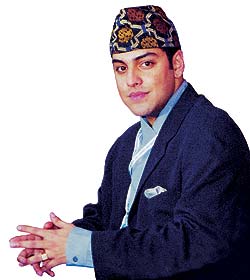 Depending on who you talk to, King Gyanendra\'s appointment of his son and heir apparent, Paras, as Crown Prince on Dasain Tika day was either a masterstroke or callous disregard for the sentiments of the Nepali people.
Depending on who you talk to, King Gyanendra\'s appointment of his son and heir apparent, Paras, as Crown Prince on Dasain Tika day was either a masterstroke or callous disregard for the sentiments of the Nepali people. Five months after the 1 June royal massacre, most Nepalis had just started coming to terms with the numbing reality of the killings. Even those still sceptical about Dipendra\'s involvement were getting on with their lives. King Gyanendra, who had the throne thrust on him, had been subtly trying to change public perception in his favour through carefully calibrated media exposure. This is why everyone thought he would wait before doing the inevitable: naming his unpopular son crown prince.
After all, Paras had been in the news for all the wrong reasons. Known as a royal brat, he had been involved in hit-and-run incidents, the latest on the night of 6 August 2000, when his Pajero allegedly ran down musician Praveen Gurung. There was a public outcry, angry editorials and street protests calling for the wayward prince to be stripped of his title. Praveen\'s family decided not to pursue the case, and there were reports that his widow was offered Rs 1 million.
Paras later earned some measure of public goodwill when the Keshab Upadhyay probe committee report detailed how he had saved the lives of several royal family members on the night of 1 June by shielding them from Dipendra. And lately, Paras has been seen more frequently on television, at official and religious functions. Many in Kathmandu were following the palace\'s efforts to rehabilitate Paras, but were surprised it happened so soon. Sources said even palace and government officials only heard it on Radio Nepal\'s morning news on 26 October.
It was shrewd timing. The country was closed for Dasain, and most political parties were in hibernation. Immediate reaction was muted. Most surprising was Bam Dev Gautam of the Marxist-Leninists, the very party that staged anti-Paras demos outside Nirmal Niwas last August. Gautam said: "The declaration of the Crown Prince has happened according to royal traditions and constitutional provisions."
In a measured response, Narahari Acharya of the ruling Nepali Congress: "Nepalis have the right to be assured of the character and behaviour of a person who will sit on the throne."
The main opposition UML\'s Madhav Nepal, who had no comment last week, did one of his rapid turnarounds: "The royal family should move with the times, the monarchy needs to be more transparent, especially in the post-massacre phase when it is insecure."
Although he knows his son\'s reputation, King Gyanendra didn\'t have any other choice. He and his son are the only male members left in the royal family after the massacre, and the prolonged absence of a line of succession would have been highly unusual. Said one source close to the royal family: "There are so many procedures and traditional functions that need a crown prince to be present, and this is why there was a degree of urgency." One of these was the need to name a royal caretaker when the King and Queen Komal travel abroad, which could be soon for the Queen\'s health check-up in the UK. Even so, critics of the decision to name Paras crown prince are not satisfied. "Here is a man who at the very least owes the Nepali public an apology," says academic Pitamber Sharma. "And doing it hurriedly, during Dasain, without political consultation, was like hoodwinking the people."
Several others took the decision as proof of the constitutional ambivalence about palace affairs, and agreed that as a modern monarchy there should have been an effort by the palace towards more transparency. One left-leaning politician told us: "We understand that the king really had no choice, all we are questioning is the procedure and timing." Said another: "What it showed is that the people trust the monarchy, but the monarchy still does not trust the people enough to take a decision like this without consulting parliament." Whatever the case, both supporters and opponents of the decision agree that Crown Prince Paras has a public relations challenge ahead of him, and needs to be careful about his behaviour here on.
Already there are signs that he is mending his ways. The Himalaya Times Wednesday printed a front page piece with excerpts of verses penned by Paras after the royal massacre:
Before my eyes, I lost all
What did my helpless eyes have to see.
My luckless eyes,
Their luckless ears,
They believe what they hear
Not what they see.


